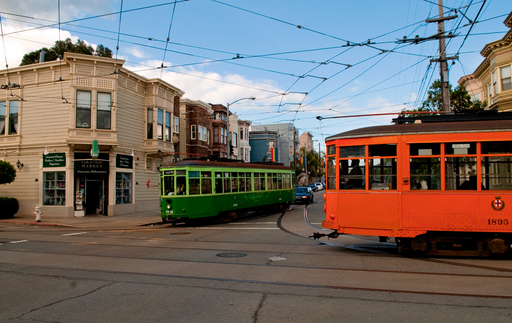
Peter Witts trams 1818 & 1895, both from far-off Milan, Italy exchange greetings at the interesection of 17th & Noe streets in San Francisco, California of all places. If the casual passerby were to stop just long enough, close their eyes and just listen. Listen long enough to the air that “hisses” from the pneumatic brake system. The smooth rolling sound of a steel wheel on steel rail. The “toot” of the air whistle and the groan of the brakes.
Keeping their eyes closed and continuing to listen, it is almost possible to mistake this street corner for the Piazza Cordusio. One of Milan’s two major town squares, and a major hub for its streetcars. The same causal passerby now opens his or her eyes, and what lies before them?
17th & Noe in San Francisco. A place where streetcars – or trams if you will – from exotic ports-of-call roam the streets. A place where if you close your eyes from just long enough, it’s possible to travel away without ever leaving home.
Great photo!
I agree. I must add that I really like the green scheme that 1818 wears. It’s quite soothing to the eyes. Can’t wait for 1888 to get back out onto the streets with the same scheme too. Anyone know when will that happen?
Is 1888 being repainted in green? What about the rest? I really like the yellow one and there are a lot of US cities that ran Peter Witt trolleys too, weren’t there?
1888 will be repainted in green like 1818 after accident repairs are complete; 1807 will be repainted yellow and white, like 1811, when it comes out of the shop. Over time, the plan is to even out the fleet between the three Milan liveries. Thought was given at one time to painting some of the Witts in U.S. liveries, but that would mean removing the signage, inside as well as out, that a lot of San Franciscans really like about the cars. They’re also really quite different looking than most of the North American Witts.
Rick, the Italian signs inside were one of the best things about riding them, but Muni opted for a cheap buck and filled them with ads for crap on the wharf and no-smoking ads for gay people.
It’s a shame, but not a surprise, that Muni would destroy the interior of a historic trolley since there was a cheap buck to be made letting advertising invade yet another space. I’m surprised they aren’t just wrapped in ads by now like they’re starting to do (who cares if you can’t see out and it makes it dark and claustrophobic) on the trains.
I was intrigued by Greg’s question about the number of US cities that had “Peter Witt” cars. PCC’s have been covered in several books, but I don’t know of a reference that would tell how many systems ran “Witts”. Los Angeles Ry. had only two. As I recall, Cleveland and Toronto had large fleets of them. Pacific Electric “Hollywood” cars have been characterized as “modified Peter Witts” by at least one author.
We still had Peter Witt trams in Torino at least up until a few years ago. It’s a two tone green as well, but the colors are a little less saturated than on 1818 (I remember the green Milano being a lot less minty) and that the upper and lower sections actually complimented them better that what’s shown on 1818 with a yellow strip
My point is that if you wanted to show another city, you wouldn’t have to change any of the italian signs (beside the Milano logo) to paint one for Torino.
@Joshua, the Italian signage I referred to is the directional and informational signage permanently mounted on the car interior, not the ads (for things like cooking oil) that came over on the cars from Italy.
The interiors of the F-line cars have always been open to advertising. The Milan cars escaped having their Italian ads taken down for a long time because the ad spaces are a different size than US standard. Toward the end of its tenure, the old Muni ad contractor finally figured out the value of selling the Milan cars’ inside space.
The F-line cars don’t have exterior advertising because Market Street Railway, along with those of like mind on the SFMTA Board of Directors, worked to exclude exterior vintage streetcar advertising from the past two Muni ad contracts, including the current one. Some may wish there was no interior advertising either. Some may also wish there were twice as many cars on the F-line and they were free. In this budget environment, neither wish is realistic.